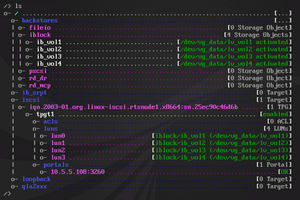This article has multiple issues. Please help improve it or discuss these issues on the talk page. (Learn how and when to remove these messages)
|
 LIO Linux SCSI Target | |
| Original author(s) | Nicholas Bellinger Jerome Martin |
|---|---|
| Developer(s) | Datera, Inc. |
| Initial release | January 14, 2011 |
| Repository | github |
| Written in | C, Python |
| Operating system | Linux |
| Type | Block storage |
| License | GNU General Public License |
| Website | linux-iscsi |
The Linux-IO Target (LIO) is an open-source Small Computer System Interface (SCSI) target implementation included with the Linux kernel.[1]
Unlike initiators, which begin sessions, LIO functions as a target, presenting one or more Logical Unit Numbers (LUNs) to a SCSI initiator, receiving SCSI commands, and managing the input/output data transfers.[2]
LIO supports a wide range of storage protocols and transport fabrics, including but not limited to Fibre Channel over Ethernet (FCoE), Fibre Channel, IEEE 1394 and iSCSI.[3]
It is utilized in several Linux distributions and is a popular choice for cloud environments due to its integration with tools like QEMU/KVM, libvirt, and OpenStack.[4]
The LIO project is maintained by Datera, Inc.,[dubious – discuss] a Silicon Valley-based storage solutions provider. On January 15, 2011, LIO was merged into the Linux kernel mainline with version 2.6.38, which was officially released on March 14, 2011.[5][6] Subsequent versions of the Linux kernel have introduced additional fabric modules to expand its compatibility.[citation needed]
LIO competes with other SCSI target modules in the Linux ecosystem. The SCSI Target Framework (SCST)[7] is a prominent alternative for general SCSI target functionality, while for iSCSI-specific targets, the older iSCSI Enterprise Target (IET) and SCSI Target Framework (STGT) also have industry adoption.[8][9]
- ^ Target. 323328-001. linux-iscsi.org. 2012-10-23. Retrieved 2012-12-25.
- ^ RFC 7144 - Internet Small Computer System Interface (iSCSI) Requirements and Implications for the Data Center (April 2014)
- ^ RFC 7144 - Internet Small Computer System Interface (iSCSI) Requirements and Implications for the Data Center (April 2014)
- ^ "A tale of two SCSI targets". Lwn.net. Archived from the original on 2014-02-02. Retrieved 2014-01-20.
- ^ Linus Torvalds (2011-01-14). "Trivial merge". Kernel.org. Retrieved 2019-09-28.
- ^ Thorsten Leemhuis (2011-03-02). "Kernel Log: Coming in 2.6.38 (Part 4) - Storage". Heise Online.
- ^ "A tale of two SCSI targets". Lwn.net. Archived from the original on 2014-02-02. Retrieved 2014-01-20.
- ^ Haas, Florian (May 2012). "Replicate Everything! Highly Available iSCSI Storage with DRBD and Pacemaker". Linux Journal. Archived from the original on 2014-01-20. Retrieved 2019-09-28.
- ^ Bolkhovitin, Vladislav (2018-04-11). "SCST vs STGT". Generic SCSI Target Subsystem for Linux. Retrieved 2019-04-01.